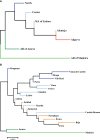HLA frequency distribution of the Portuguese bone marrow donor registry
- PMID: 38149254
- PMCID: PMC10749969
- DOI: 10.3389/fimmu.2023.1286001
HLA frequency distribution of the Portuguese bone marrow donor registry
Abstract
Introduction: The Portuguese donor Registry of CEDACE was the fifth largest per capita bone marrow donor Registry of the WMDA as of 2019 and has yet to be thoroughly analyzed. We aimed to characterize its various aspects, including demographics and HLA allele and haplotype frequencies, to evaluate the genetic matching propensity score and ultimately further develop it.
Methods: We described and compared characteristics of the donor population with census data and used an Expectation-Maximization algorithm and analyses of molecular variance to assess haplotype frequencies and establish phylogenetic distances between regions and districts within the country.
Results: We identified 396545 donors, corresponding to 3.85% of the Portuguese population; the median donor age was 39 years, with 60.4% of female donors. Most donors were Portuguese nationals, although 40 other nationalities were present, with a significant proportion of donors from Brazil and Portuguese-speaking African Countries; almost all donors self-reported as Western, with the second largest group reporting African ancestry. There was an asymmetric contribution of donors from different districts and regions, with most coming from coastal districts and few from the southern districts and autonomous regions; foreign and self-declared non-Western donors were mainly located in the Metropolitan Area of Lisbon and the South. Although most donors were typed in three loci (HLA-A, HLA-B and HLA-DRB1), only 44% were also typed in HLA-C, 1.28% in HLA-DQB1 and only 0.77% in all five loci and in high-resolution. There were varying allele and haplotype frequencies across districts and regions, with the most common three loci, low-resolution haplotypes, being HLA-A*01~B*08~DRB1*03, A*29~B*44~DRB1*07 and HLA-A*02~B*44~DRB1*04; some haplotypes were more prevalent in the South, others in the North and a few in the autonomous regions; African and foreign donors presented relevant differences in haplotype frequency distributions, including rare haplotypes of potential interest. We also report on four loci, low-resolution frequency distributions. Using AMOVA, we compared genetic distances between districts and regions, which recapitulated the country's geography.
Discussion: Our analysis showed potential paths to optimization of the Registry, including increasing the male donor pool and focusing on underrepresented districts and particular populations of interest, such as donors from Portuguese-speaking African countries.
Keywords: CEDACE; HLA; Portugal; Portuguese-speaking African countries; haplotype frequencies.
Copyright © 2023 Espada, Ligeiro, Trindade and Lacerda.
Conflict of interest statement
The authors declare that the research was conducted in the absence of any commercial or financial relationships that could be construed as a potential conflict of interest.
Figures







References
-
- Fernandez Vina MA, Hollenbach JA, Lyke KE, Sztein MB, Maiers M, Klitz W, et al. Tracking human migrations by the analysis of the distribution of HLA alleles, lineages and haplotypes in closed and open populations. Philos Trans R Soc Lond B Biol Sci (2012) 367(1590):820–9. doi: 10.1098/rstb.2011.0320 - DOI - PMC - PubMed
Publication types
MeSH terms
Substances
LinkOut - more resources
Full Text Sources
Medical
Research Materials

